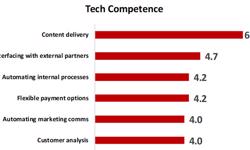Three years ago, it was all very different. The overriding sentiment coming through from the consumer magazine and business publishers surveyed for Publishing Futures was one of panic and doom. In the face of the digital tsunami, there were concerns about structural declines in revenues amid the wider economic gloom.
Go back two years and the mood had changed to one of stressed anxiety. On the positive side, the economy was forecast to recover and the launch of the iPad gave new hope that end-users would pay for digital products. And yet publishers were now facing so many options that there was great stress about knowing which plates to spin.
One year ago, it was all hectic activity. The industry had a better idea of which plates to spin, but faced the challenge of understanding how to spin them all quickly enough. There was also a realisation that the economy was going to bounce along the bottom for some time to come, with the prospect of a long, slow and grinding clawback in publishing revenues.
Now, the industry is deep into exhausting activity. Revenues are bobbling up and down and are coming back slowly in specific markets. Publishers have become smarter about what needs to be done – the issue now is how to spin different plates at different speeds.
The central shift in this year’s survey is that the industry has become more outward-looking. The lethargic state of the UK economy is now simply an accepted fact, and opportunities in overseas markets are growing with both advertisers and customers. There is less focus on internal, organisational issues and, while they remain a concern, less anxiety about skills gaps. There is less emphasis on cutting costs and more on growing revenues. Investment and marketing budgets are growing slowly, even though they are being spread more thinly across more platforms. Essentially, the business is simply getting on with managing the challenges in a measured and pragmatic way.
There are four significant qualifications:
1. While harnessing the power of digital remains at the core of publisher thinking currently, there is a more knowing understanding of the dangers of some of the emerging business models. There is also a clear recognition of the value of old, legacy products in both keeping revenues and profits flowing and in giving substance to the brand.
2. B2B is ahead of consumer publishing in terms of re-engineering the organisation and of seeing a clearer digital future. The change and volatility in consumer consumption patterns is still causing massive turbulence.
3. There is a clear concern among a number of smaller publishers, especially in B2B, that they do not have the scale and resource to prosper in the austere and challenging environment. Yet they also recognise that they have an agility and speed that larger companies sometimes lack. There is an acceptance that they may need to achieve “virtual scale” by working more closely with partners and even competitors to achieve their business aims. Few publishers are big enough to put all their ideas into action on their own. There is also a growing mood of collaboration and knowledge-sharing right across the industry.
4. For every publisher, the task of managing a widening range of fragmenting channels is a major and ongoing strain on both individuals and organisations.
POSITIVE INDICATORS
Turnovers erratic, but moving in the right direction: Industry turnover is growing currently, but faster in B2B than consumer which remains turbulent. There is growing optimism about the prospects for the coming year.
Profit margins edging up: While turnovers have been erratic over the last four years, profits have been much more stable: the result of determined cost control and, in some cases, major re-engineering. More publishers are moving into profit and the profitable companies are edging up their margins – a trend that will continue through 2013.
Headcount growing again: After some ups and downs, industry staff numbers are rising modestly.
Marketing budgets growing, but spread more thinly: Total publisher investment in promotions and research is rising, but the range of channels and platforms being managed is increasing too.
Publisher confidence growing: All these positive financial indicators are feeding through into a growing confidence about business prospects over the next two years.
SHIFTING REVENUE STREAMS
There are significant differences from sector to sector, but there are also some key, broad trends.
While print is losing share in both consumer and B2B, it is still massively important in terms of both revenue and brand-presence.
The balance between the circulation and advertising streams is very different between consumer (where advertising accounts for 38% of print revenues) and B2B (70%), but that balance is shifting slightly away from advertising to circulation in both markets.
Own digital brands
The falls in the share of own print brands are being balanced by the share growth in digital in both consumer and B2B.
Within this digital stream, advertising and sponsorship accounts for the majority of the revenue – 72% in consumer and 56% in B2B. There is little change to the balance over the next two years for B2B, but consumer is budgeting for a significant growth in ecommerce.
Customer publishing
This is a relatively small area for brand publishers (6% of consumer and 1% of B2B total revenues), but it is still significant as traditional publishers sell their skills to non-publishers.
Other extensions
Brand extensions cover a range of products and services from live events through to data services.
* For consumer, these form a small, but growing area: 7% rising to 8% in two years’ time.
* For B2B, these are a core activity: 37%, edging up to 38%.
THE GROWTH IN OVERSEAS SALES
Behind these shifts in the broad revenue streams lies the growing internationalisation of publishing as domestic UK markets remain sluggish and as digital drives through national barriers, opening up new growth opportunities.
* Overseas sales account for 21% of total consumer revenues currently, rising to 22% in two years’ time.
* For B2B, current overseas sales total 46% currently, rising to 50%.
A more detailed breakdown of the revenue streams is shown in the two tables.
MANAGING A CHANGING BUSINESS
There has been a subtle shift in attitude since the 2012 survey. Streamlining the business has reduced in importance while developing revenues, especially through new products, is receiving more priority. Yet it is clear that the B2B sector is further down the re-engineering road than consumer.
Business streamlining
* Improving the efficiency of internal processes remains the key priority.
* Cutting general costs and renegotiating supplier deals are in second place, but are dropping in terms of importance.
* Cutting headcount is no longer the priority that it was a few years ago, but is edging up again – keeping the organisation lean is the constant context.
* Selling off non-core operations is still on the agenda, but is much more about taking advantage of tactical opportunities rather than a major strategic intent for most publishers.
Tweaking existing product & services
* Creating more creative, multi-channel ad packages is a high priority.
* Developing overseas opportunities is rising in importance.
* The need to reposition established brands is a growing priority.
* Increasing end-user prices is an important issue, but with a lower priority than other areas. Getting online pricing right is absorbing more thought than the pricing of print products.
Developing new products
* Launching new digital products is the single highest priority in the whole survey and continues to rise in importance.
* Launching new print products, predictably, lags well behind digital, but shows a strong year-on-year rise in priority – print still has an important role in a multi-channel portfolio.
* Launching completely new products & services has a solid score, but has dropped in priority year-on-year – actually making this happen is harder than it looks.
* Growth through acquisition is a low priority, but is rising in importance – more of a tactical move should an opportunity appear, but not part of the core plan.
STRATEGIC ISSUES
Standing back from the day-to-day detail of the business, there is a range of recurring issues across the industry.
Strategic opportunities
* A wider range of activities is offering revenue opportunities as well as a more balanced offer to both advertisers and end-customers. Increasingly, print is being seen as an integral part of this multi-channel mix rather than an obsolete activity to be left behind.
* More publishers are emerging with remodelled businesses: more efficient and better able to ride any economic storms and the increasing competition. The remodelling has been driven by creating a more customer-focused business, based on deeper insights. The result is that the operation is better equipped to handle new channels as well as to manage existing channels better.
* Publishers have clearly become more outward-looking. This includes internationalisation, more focus on partnerships with external companies, access to new (often younger) audiences and more sophisticated niching of content and services. Yet coupled with this is a recognition that “doing fewer things better” must be a pragmatic aim.
Strategic challenges
* The economic environment is clearly shaping everything, but there is actually less comment on this than in previous years’ surveys. The economy impacts on advertising budgets and on the end-users’ willingness to pay for content and services. It is also making brand owners look at going direct to their own customers rather than using the intermediation of a “publisher”.
* Rising cost pressures include paper, print, postage and retail promotions. Being ready to manage fast and constant change is adding to internal development costs.
* There are still resource concerns – budgets; staff numbers; staff quality, experience and skills, especially in digital.
* How to keep all the plates spinning in practical terms. Is the organisation structured correctly? Is there a real vision for the company? When does the rising revenue line of digital cross over the declining revenue line of print? Does the organisation have the self-belief, self-confidence and resilience to keep on going through constant change?
In a fast-moving and challenging world, where failure and dead-ends are simply part of the process of constant experimentation, more subjective qualities are coming to the fore. Ensuring that organisational structures and processes are fit-for-purpose is still critical. Yet corporate qualities such as self-confidence, self-belief and resilience are now seen as being essential. The survey demonstrates that the publishing business does have those qualities and is putting them to good use in a challenging environment.
The Publishing Futures 2013 report and an edited executive summary are available free to PPA members. The report is available for non-members to purchase for £495+VAT. For further details, contact Nicola Rowe.












